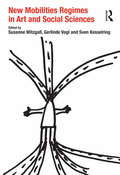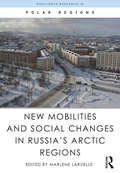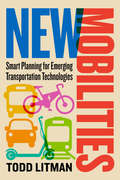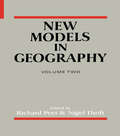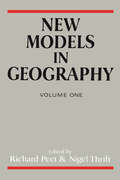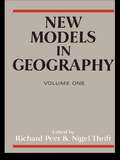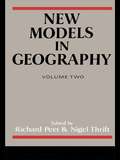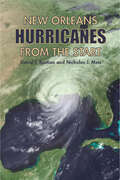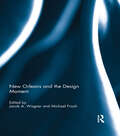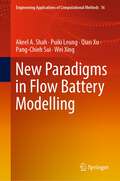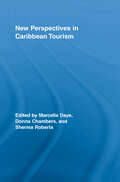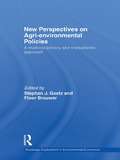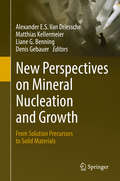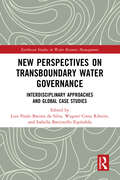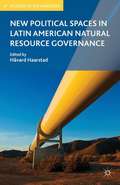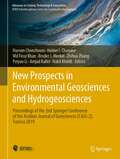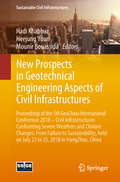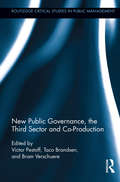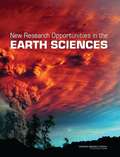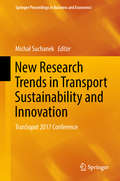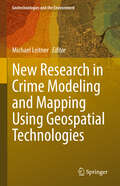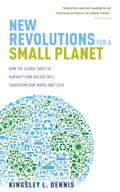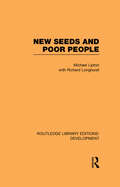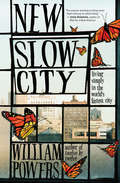- Table View
- List View
New Mobilities Regimes in Art and Social Sciences: Mobility And Power In The Social Sciences And The Arts
by Susanne Witzgall Gerlinde VoglNew Mobilities Regimes analyses how global mobilities are changing the world of today and the role of political and economic power. Bringing together essays by leading scholars and social scientists, including Mimi Sheller and Bülent Diken with the work of well-known artists and art theorists such as Jordan Crandall, Ursula Bieman, Gülsün Karamustafa and Dan Perjovschi this book is a unique document of the cross-disciplinary mobility and power discourse. The specific design, integrating the text and art elements to create a singular dialogue makes for an exciting intellectual and aesthetic experience. Illustrated by a range of studies which examine the regulation and structure of mobility, such as the daily routines of teleworkers, Ukrainian cleaners in Western Europe, the mobility policies of global corporations, and the impact of bicycle policies on public space, New Mobilities Regimes emphasizes the routes and crossroads of migration flows as well as at the interaction of mobility and new spatial concepts. The contributors are concerned with both the positive outcomes and the disappointments of the global mobilizations in modern lives. This book is ground-breaking in that it calls for the reassessment of the figurative arts in providing independent and insightful knowledge-generating research on the nature of mobility and highlights the new appreciation of visual representations in sociology, cultural geography and anthropology.
New Mobilities and Social Changes in Russia's Arctic Regions (Routledge Research in Polar Regions)
by Marlene LaruelleThis book provides the first in-depth, multidisciplinary study of re-urbanization in Russia’s Arctic regions, with a specific focus on new mobility patterns, and the resulting birth of new urban Arctic identities in which newcomers and labor migrants form a rising part of. It is an invaluable reference for all those interested in current trends in circumpolar regions, showing how the Arctic region is becoming more diverse culturally, but also more integrated into globalized trends in terms of economic development, urban sustainability and migration.
New Mobilities: Smart Planning for Emerging Transportation Technologies
by Todd LitmanIn New Mobilities: Smart Planning for Emerging Transportation Technologies, transportation expert Todd Litman examines 12 emerging transportation modes and services that are likely to significantly affect our lives: bike- and carsharing, micro-mobilities, ridehailing and micro-transit, public transit innovations, telework, autonomous and electric vehicles, air taxis, mobility prioritization, and logistics management.Public policies around New Mobilities can either help create heaven, a well-planned transportation system that uses new technologies intelligently, or hell, a poorly planned transportation system that is overwhelmed by conflicting and costly, unhealthy, and inequitable modes. His expert analysis will help planners, local policymakers, and concerned citizens to make informed choices about the New Mobility revolution.
New Models In Geography V2: The Political-economy Perspective
by Richard Peet Nigel ThriftFirst published in 1989. The publication of Models in geography presaged a sea change in the practice of Anglo-American geography. For a new set of models, this book provides a summary of their nature, spirit and purpose based upon a political-economy perspective. The book is split into two volumes, each consisting of four parts. This makes the title suitable for students and geographers with an interest in models of the city, civil society and social theory.
New Models In Geography: Volume 1
by Richard Peet Nigel ThriftFirst published in 1989. It seems such a long time ago, another age—yet it is a mere twenty-odd years since the original Models in Geography was published. It is an even shorter time since the first tentative steps were taken towards an alternative formulation of what might constitute a geographical perspective within the social sciences. What came to be called the political-economy perspective has progressed with remarkable speed and energy to generate its own framework of conceptualization and analysis, its own questions and debates. The papers in these two volumes are witness to the richness and range of the work which has developed over this relatively short period within the political economy approach. Moreover, from being a debate within an institutionally defined ‘discipline of geography’, to introducing into that discipline ideas and discussions from the wider fields of philosophy and social science and the humanities more generally, it has now flowered into a consistent part of enquiries that span the entire realm of social studies.
New Models in Geography - Vol 1: The Political-Economy Perspective
by Richard Peet Nigel ThriftFirst Published in 2004. Routledge is an imprint of Taylor & Francis, an informa company.
New Models in Geography - Vol 2: The Political-Economy Perspective
by Richard Peet Nigel ThrifTwo decades after the publication of the seminal Models in Geography, edited by Richard Chorley & Peter Haggett, this major collection of specially commissioned essays charts the new human geography from the perspective of political economy. Providing surveys of recent trends in theory, bibliographic guides to the literature, and pointers to advances and frontiers in thinking, the book ranges from cultural to economic and urban geography. The authors explore the connections between political economy and geographical thought in each area, with the emphasis lying on the processes of material production and social reproduction.
New Models in Geography: The Political-Economy Perspective
by Richard Peet Nigel ThriftFirst Published in 1989. Routledge is an imprint of Taylor & Francis, an informa company.
New Orleans Hurricanes from the Start
by David Bastian Nicholas J. MeisAn encyclopedic history of the Crescent City&’s most violent storms, with analysis, predictions, and suggestions for the future protections. According to the US Army Corps of Engineers, the city of New Orleans is twice as likely to be struck by a hurricane as any other metropolitan area bordering the Gulf of Mexico. In this work, authors David F. Bastian and Nicholas J. Meis explore the historical records of storms that have affected the region in and around south Louisiana since the first colonizers set foot on the Mississippi delta in the late seventeenth century. Using letters, personal diaries, official records, newspaper articles, and expert analyses, Bastian and Meis delve into the effects of the monstrous storms that have irreparably impacted south Louisiana, including what went awry during Katrina in 2005. Also examined is the evolution of New Orleans's protection systems as well as what the city can do to avoid another catastrophe.
New Orleans and the Design Moment
by Jacob A. Wagner Michael FrischFollowing the disaster of Hurricane Katrina in New Orleans, people began to discuss and visualize the ways in which the urban structure of the city could be reorganized. Rather than defining the disaster recovery process as simply a matter of rebuilding the existing city, these voices called for a more radical rethinking of the city’s physical, social and environmental systems. This idea of disaster as an opportunity for urban restructuring is a hallmark of a "design moment." Design moments are different from the incremental process of urban growth and development. Instead of gradual growth and change, design moments present the opportunity for a significant restructuring of urban form that can shape the city for decades to come. As such, a design moment presents a critical juncture in the historical growth and development of a city. In this book we explore the question: what does urban design have to do with a disaster like Hurricane Katrina? Focused on New Orleans, the authors explore different dimensions of the post-disaster design moment, including the politics of physical redevelopment, the city’s history and identity, justice and the image of the city, demolition and housing development, and the environmental aspects of the recovery process. This book was published as a special issue of the Journal of Urban Design.
New Paradigms in Flow Battery Modelling (Engineering Applications of Computational Methods #16)
by Qian Xu Pang-Chieh Sui Akeel A. Shah Puiki Leung Wei XingThis book provides a comprehensive review of the latest modelling developments in flow batteries, as well as some new results and insights. Flow batteries have long been considered the most flexible answer to grid scale energy storage, and modelling is a key component in their development. Recent modelling has moved beyond macroscopic methods, towards mesoscopic and smaller scales to select materials and design components. This is important for both fundamental understanding and the design of new electrode, catalyst and electrolyte materials. There has also been a recent explosion in interest in machine learning for electrochemical energy technologies. The scope of the book includes these latest developments and is focused on advanced techniques, rather than traditional modelling paradigms. The aim of this book is to introduce these concepts and methods to flow battery researcher, but the book would have a much broader appeal since these methods also employed in other battery and fuel cell systems and far beyond. The methods will be described in detail (necessary fundamental material in Appendices). The book appeals to graduate students and researchers in academia/industry working in electrochemical systems, or those working in computational chemistry/machine learning wishing to seek new application areas.
New Perspectives in Caribbean Tourism
by Donna Chambers Sherma Roberts Marcella DayeThe Caribbean is one of the most tourism dependent regions of the world. This edited volume extends beyond the frontiers of normative perspectives of tourism development to incorporate "new" ideas and perspectives that relate to the socio-cultural, political and economic realities of these societies. This edited text therefore explores tourism in t
New Perspectives on Agri-environmental Policies: A Multidisciplinary and Transatlantic Approach (Routledge Explorations In Environmental Economics Ser. #22)
by Floor Brouwer Stephan J. GoetzSignificant advances have occurred in recent years in Europe and in North America in addressing agri-environmental policies. Land use issues tend to be more pressing in Europe than in the US as a whole because of different spatial exigencies. Because these advances have taken place within individual academic disciplines, there has been something of a loss of synergy and often efforts are duplicated. While important institutional and legal differences still exist between the two continents, the sharing of recent scientific advances will benefit scientists on both sides of the Atlantic and this is the main purpose of this book. The authors aim to identify options for policy to overcome the challenges ahead, synthesize existing knowledge, and identify gaps in current knowledge. This is aided by the adoption of a properly comparative approach.
New Perspectives on Mineral Nucleation and Growth
by Alexander E.S. Van Driessche Matthias Kellermeier Liane G. Benning Denis GebauerIn the last decade, numerous studies have demonstrated the existence of alternative pathways to nucleation and crystallisation that oppose the classical view. Such proposed scenarios include multistage reactions proceeding via various precursor species and/or intermediate phases. The aim of this book is to review and discuss these recent advances in our understanding of the early stages of mineralisation through a series of contributions that address both experimental and theoretical studies about the formation and nature of initial precursor species (e. g. , prenucleation clusters, dense liquid phases, amorphous nanoparticles, etc. ) as well as their transformations leading to the stable mineral phase. Several chapters are devoted to cutting-edge analytical techniques used for investigating the above processes in situ, in real time and at conditions relevant to both natural and industrial processes. At the end of the book, the editors summarize the key questions that still need to be addressed in order to establish a complete picture of the nucleation and growth processes involved during the formation of minerals
New Perspectives on Transboundary Water Governance: Interdisciplinary Approaches and Global Case Studies (Earthscan Studies in Water Resource Management)
by Wagner Costa Ribeiro da Silva, Luis Paulo Batista Isabela Battistello EspíndolaThis book presents a novel examination of transboundary water governance, drawing on global case studies and applying new theoretical approaches. Excessive consumption and degradation of natural resources can either heighten the risks of conflicts or encourage cooperation within and among countries, and this is particularly pertinent to the governance of water. This book fills a lacuna by providing an interdisciplinary examination of transboundary water governance, presenting a range of novel and emerging theoretical approaches. Acknowledging that issues vary across different regions, the book provides a global view from South and Central America, Africa, Asia, and the Middle East, with the case studies offering civil society and public managers concrete situations that indicate difficulties and successes in water sharing between bordering countries. The volume highlights the links between natural resources, political geography, international politics, and development, with chapters delving into the role of paradiplomacy, the challenges of climate change adaptation, and the interconnections between aquifers and international development. With rising demand for water in the face of climate change, this book aims to stimulate further theoretical, conceptual, and methodological debate in the field of transboundary water governance to ensure peaceful and fair access to shared water resources. This book will be of interest to students and scholars of water resource governance from a wide variety of disciplines, including geography, international relations, global development, and law. It will also be of interest to professionals and policymakers working on natural resource governance and international cooperation.
New Political Spaces in Latin American Natural Resource Governance (Studies of the Americas)
by Håvard HaarstadCase studies written by anthropologists, geographers, political scientists, and sociologists provide empirical detail and analytical insight into states' and communities' relations to natural resource sectors, and show how resource dependencies continue to shape their political spaces.
New Prospects in Environmental Geosciences and Hydrogeosciences: Proceedings of the 2nd Springer Conference of the Arabian Journal of Geosciences (CAJG-2), Tunisia 2019 (Advances in Science, Technology & Innovation)
by Zhihua Zhang Amjad Kallel Nabil Khélifi Haroun Chenchouni Helder I. Chaminé Broder J. Merkel Md Firoz Khan Peiyue LiThis edited book gives a general overview on current research, focusing on geoenvironmental issues and challenges in hydrogeosciences in model regions in Asia, Europe, and America, with a focus on the Middle East and Mediterranean region and surrounding areas. This proceedings book is based on the accepted papers for oral/poster presentations at the 2nd Springer Conference of the Arabian Journal of Geosciences (CAJG-2), Tunisia 2019. It offers a broad range of recent studies that discuss the latest advances in geoenvironmental and hydrogeosciences from diverse backgrounds including climate change, geoecology, biogeochemistry, water resources management, and environmental monitoring and assessment. It shares insights on how the understanding of ecological, climatological, oceanic and hydrological processes is the key for improving practices in environment management, including the eco-responsibility, scientific integrity, and social and ethical dimensions. It is of interest to scientists, engineers, practitioners, and policymakers in the field of environmental sciences including climatology, oceanography, ecology, biogeochemistry, environmental management, hydrology, hydrogeology, and geosciences in general. In particular, this book is of great value to students and environment-related professionals for further investigations on the state of Earth systems.
New Prospects in Geotechnical Engineering Aspects of Civil Infrastructures: Proceedings of the 5th GeoChina International Conference 2018 – Civil Infrastructures Confronting Severe Weathers and Climate Changes: From Failure to Sustainability, held on July 23 to 25, 2018 in HangZhou, China (Sustainable Civil Infrastructures)
by Mounir Bouassida Hadi Khabbaz Heejung YounThis book presents new studies by a group of researchers and practitioners to address many geotechnical challenges, based on the state-of-the-art practices, innovative technologies, new research results and case histories in construction and design towards safer infrastructures. The book provides an advancement in technologies to incorporate the impact of global climate change, world's population is rising fast and the rate of urbanization on civil infrastructures. Papers were selected from the 5th GeoChina International Conference 2018 – Civil Infrastructures Confronting Severe Weathers and Climate Changes: From Failure to Sustainability, held on July 23 to 25, 2018 in HangZhou, China.
New Public Governance, the Third Sector, and Co-Production (Routledge Critical Studies in Public Management)
by Taco Brandsen Bram Verschuere Victor PestoffIn recent years public management research in a variety of disciplines has paid increasing attention to the role of citizens and the third sector in the provision of public services. Several of these efforts have employed the concept of co-production to better understand and explain this trend. This book aims to go further by systematizing the growing body of academic papers and reports that focus on various aspects of co-production and its potential contribution to new public governance. It has an interdisciplinary focus that makes a unique contribution to the body of knowledge in this field, at the cross-roads of a number of disciplines - including business administration, policy studies, political science, public management, sociology, third sector studies, etc. The unique presentation of them together in this volume both allows for comparing and contrasting these different perspectives and for potential theoretical collaboration and development. More particularly, this volume addresses the following concerns: What is the nature of co-production and what challenges does it face? How can we conceptualize the concept of co-production? How does co-production works in practice? How does co-production unfold in reality? What can be the effects of co-production? And more specific, firstly, how can co-production contribute to service quality and service management in public services, and secondly, what is the input of co-production on growing citizen involvement and development of participative democracy?
New Research Opportunities in the Earth Sciences
by Committee on New Research Opportunities in the Earth Sciences at the National Science FoundationThe 2001 National Research Council (NRC) report Basic Research Opportunities in Earth Science (BROES) described how basic research in the Earth sciences serves five national imperatives: (1) discovery, use, and conservation of natural resources; (2) characterization and mitigation of natural hazards; (3) geotechnical support of commercial and infrastructure development; (4) stewardship of the environment; and (5) terrestrial surveillance for global security and national defense. This perspective is even more pressing today, and will persist into the future, with ever-growing emphasis. Today's world-with headlines dominated by issues involving fossil fuel and water resources, earthquake and tsunami disasters claiming hundreds of thousands of lives and causing hundreds of billions of dollars in damages, profound environmental changes associated with the evolving climate system, and nuclear weapons proliferation and testing-has many urgent societal issues that need to be informed by sound understanding of the Earth sciences. A national strategy to sustain basic research and training of expertise across the full spectrum of the Earth sciences is motivated by these national imperatives. New Research Opportunities in the Earth Sciences identifies new and emerging research opportunities in the Earth sciences over the next decade, including surface and deep Earth processes and interdisciplinary research with fields such as ocean and atmospheric sciences, biology, engineering, computer science, and social and behavioral sciences. The report also identifies key instrumentation and facilities needed to support these new and emerging research opportunities. The report describes opportunities for increased cooperation in these new and emerging areas between EAR and other government agency programs, industry, and international programs, and suggests new ways that EAR can help train the next generation of Earth scientists, support young investigators, and increase the participation of underrepresented groups in the field.
New Research Trends in Transport Sustainability and Innovation: Transopot 2017 Conference (Springer Proceedings In Business And Economics)
by Michał SuchanekThis proceedings volume examines the effects of transport on socio-economic development including innovation, public health and cultural behavior. Featuring contributions presented at the 2017 TranSopot Conference in Sopot, Poland, the enclosed papers are divided to provide emerging research in transport sustainability, innovation, structure, and in municipal transport economics. Collectively, the contributions provide not only the theoretical background for transport analysis but also empirical data and practical applications. Researchers in the transport sector strive to explore the nuances of various aspects of transport economics, which are connected on many levels. The sustainability of transport fits into a wide perspective of the sustainable economy. It treats the activities of individuals, companies and local, regional and national governments as means of achieving economic and social ends. Conversely, transport sustainability has a certain burden on society as it may generate external costs in the form of congestion, pollution and negative health effects. Many of these adverse effects might be counteracted by transport innovations, both the technical ones and the organizational ones. These innovations, while their main goal might be to increase the efficiency of the transport entities, should also fit into the desirable trend of responsible economic design thinking. These general ideas of transport research naturally have to influence the research in various branches of transport ranging from the road transport to railway. Lastly, there is the municipal transport, in which goals of different stakeholders are often contradictory which leads to highly complicated decision problems. Featuring case examples on topics as bike sharing, green travel, compact cars, freight transport and electric cars, this book will be of interest to researchers, practitioners, policy makers and students in the fields of transport economics, innovation, and sustainability.
New Research in Crime Modeling and Mapping Using Geospatial Technologies (Geotechnologies and the Environment #27)
by Michael LeitnerThis edited volume offers innovative research and applications in the analysis, modelling, and mapping of crime using geospatial and GeoAI technologies. This is a follow-up publication of an edited volume by the same editor with a similar title, Crime Modeling and Mapping Using Geospatial Technologies, published by Springer in its popular Geotechnologies and the Environment series in 2013. The book comprises sixteen chapters authored by some of the most esteemed researchers in the field. These chapters are organized into four sections: big data and microspaces (Part I), mobility (Part II), drugs (Part III), and additional geospatial applications (Part IV). Part I includes five chapters focusing on interactive crime mapping by using large data sets obtained from social media and analyzing these data using AI applications; a fundamental spatial problem that considers spatial properties of a crime dataset to determine an adequate areal unit size; different aspects of the influence or prediction of crime in microspaces; and the use of sampled surface pollen to model the search space for documented forensic cases. Part II has four chapters that introduce two route generation heuristics that automate the creation of hot spots policing patrol routes; discuss how to optimize police response with two different maximal covering location problems; and examine how human mobility patterns impact crime trends and modelling. Part III consists of three chapters addressing opioid overdose patterns using a spatial mixed methods approach; spatial-temporal changes in hot spots of drug-related offences; and how geospatial technology can be used to empower stakeholders to make informed policy decisions about alcohol-related motor vehicle collisions. Part IV comprises four diverse chapters that do not fit under a single theme. The topics discussed include: the impact of video surveillance on the spatial distribution of crime; the identification of the location of missing persons outreach events with spatial clustering analysis methods; an examination of the distribution patterns of all types of juvenile delinquency to investigate underlying factors; and a review and comparison of GeoAI methods for detecting and mapping illegal logging. This book would be useful to faculty, students and research scholars from geography, sociology, criminal justice, criminology, forensic sciences, and other related disciplines as well as to crime analysts working for law enforcement agencies at the local, state, or federal levels from around the world.
New Revolutions for a Small Planet
by Kingsley DennisHumanity is in the midst of great transformation. Our world is undergoing three types of revolution, all co-dependent: physical, psychic and cosmological. The media report dramatic changes due to climatic disruption: earthquakes, floods, hurricanes, and volcanic eruptions. We are also witnessing a surge in popular protest, as decades of corrupt or inefficient social systems face their nemesis. Yet within this outward turmoil more subtle shifts are occurring, such as the transition of the 'modern' mind from the industrial-globalisation model towards a life-sustaining, ecological-cosmological world-view. Western thinking, with its linear notion of history and progress, has robbed us of enchantment. Many ancient teachings (both spiritual and secular) and many indigenous cultures speak to us of cyclic processes over long periods of historical time. This book looks at the concept of the Hindu Yugas (great cycles) that reflect the rise and fall of civilisations, as well as ebbs and flows in our moral and intellectual health. In the years to come, humanity will adapt itself to a world in revolution, and our lives will be re-energised. This book provides a user's guide to new worlds and new world-views, and to 'a fresh release of spiritual energy'.
New Seeds and Poor People (Routledge Library Editions: Development)
by Michael Lipton Richard LonghurstFirst published in 1989, this book deals with the impact of cereal production upon the Third World, specifically ‘Modern Varieties’ (MVs). Using evidence from plant breeding, economics and nutrition science, the authors seek to pinpoint what has been achieved, what has gone wrong and what needs to be done in future. Although the technical innovations of MVs mean more employment, cheaper food and less risk for small farmers, the reduction in crop diversity increases the risk of danger from pests and though MVs enlarge cereal stocks, many are too poor to afford them. The book concludes that technical breakthroughs alone won’t solve deep-rooted social problems and that only new policies and research priorities will increase the choices, assets and power of the rural poor.
New Slow City
by William PowersBurned-out after years of doing development work around the world, William Powers spent a season in a 12-foot-by-12-foot cabin off the grid in North Carolina, as recounted in his award-winning memoir Twelve by Twelve. Could he live a similarly minimalist life in the heart of New York City? To find out, Powers and his wife jettisoned 80 percent of their stuff, left their 2,000-square-foot Queens townhouse, and moved into a 350-square-foot "micro-apartment” in Greenwich Village. Downshifting to a two-day workweek, Powers explores the viability of Slow Food and Slow Money, technology fasts and urban sanctuaries. Discovering a colorful cast of New Yorkers attempting to resist the culture of Total Work, Powers offers an inspiring exploration for anyone trying to make urban life more people- and planet-friendly.
